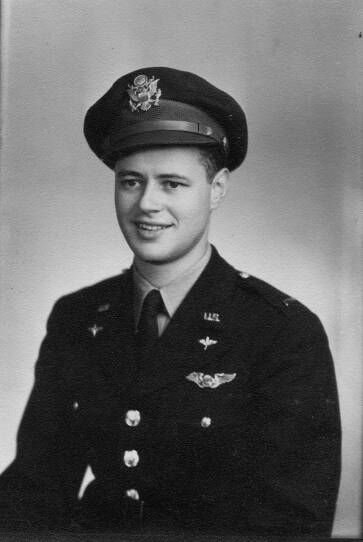The families of Missing in Action servicemen experience a complicated kind of grief, but Samuel H. Bahn expressed what his family has been through in two devastating lines.
“In the Jewish tradition, it’s customary for burial to take place no more than 72 hours after death. For our dear Dickie Horwitz, it’s taken 72 years," he said.

Finally, Bahn said, at Levine Chapels, his cousin would have “a dignified funeral to mourn his passing and to honor the true Brookline patriot who did his duty bravely, paying the ultimate price for his country.”
“Dickie” was 2nd Lt. Richard M. Horwitz, who served as a navigator aboard a B-24 aircraft that was lost in 1945. “They were bombing a railroad bridge, and when they finished bombing it, they were hit by flak,” according to one of his surviving cousins, Joyce Bahn Schwartz. She’s absorbed the report on Horwitz compiled by the Defense POW/MIA Accounting Agency (DPAA) so well, she can recite the details.
“His plane was bombing a bridge in the Brenner Pass, trying to prevent supplies going back and forth," she said. "This is about two and a half months before the war is over, totally over, in Europe."
Schwartz says the American troops were trying to prevent Nazi troops from resupplying in northern Italy, and were trying to isolate them.They were bombing the railroad bridge so the Nazi troops couldn't get back into Germany to defend it. That's when the plane was hit.
"[The flak] hit the No. 3 engine and the No. 4 engine. The No. 3 engine controls the hydraulics of the entire plane … [so] there was no way to steer this thing," Schwartz said. “My aunt and uncle were told the plane went down in the Austrian Alps, and for years and years, they believed that."
But the plane actually crashed in the northern Adriatic Sea. In 2013, some local divers found the wreck off the coast of Grado, Italy, and photographed it.
“They were able to get the number off the rudder. They sent that along to the U.S. government. The U.S. government said, ‘Ah ha! That's this plane. We know this plane.’ And they also saw osseous remains. In other words, bony remains," Schwartz said.
Forensic scientists at the DPAA went through a painstaking process to identify the remains, ultimately matching DNA to a surviving family member, Jonathan McHugh, the son of another of Dickie’s cousins. At the funeral on Sunday, McHugh read a poem expressing his joy at being the genetic connection to his long-lost relative, and gratitude to “Dickie” for pulling the family together.
Schwartz says that the entire family never gave up hope of Horwitz’s return. “Growing up we just missed him. It was like, ‘He’s supposed to be there — where is he?’ It usually came up at the holidays, either Thanksgiving or Passover or something like that, when we would all be together as a family. His presence was missed.”

She regrets that some of the family members who kept the faith and worked to find Horwitz didn’t survive to see this.
“I tear up periodically, but it's not because I'm sad about my cousin. It's sad that his parents and his brothers aren't here. That's the reason," Schwartz said. "I mean, other than that, this, to us, is not a sad occasion because we've got him back.”
Schwartz says that before she died, Horwitz’s mother gave her and the other cousins a mission.
“We were to keep looking and not be satisfied until we got him home. Even though it's possible that it would never happen,” she said, her voice breaking. “It was like a missing piece. When we went to pick him up at the airport, it was nice to get him back, but when we got him to Levine's in Brookline, we said, 'You’re home, Dickie! It's Brookline! You're home!'"
After the service at Levine Chapels, Horwitz was accompanied by an honor guard to West Roxbury, where he was laid to rest in a family plot.





